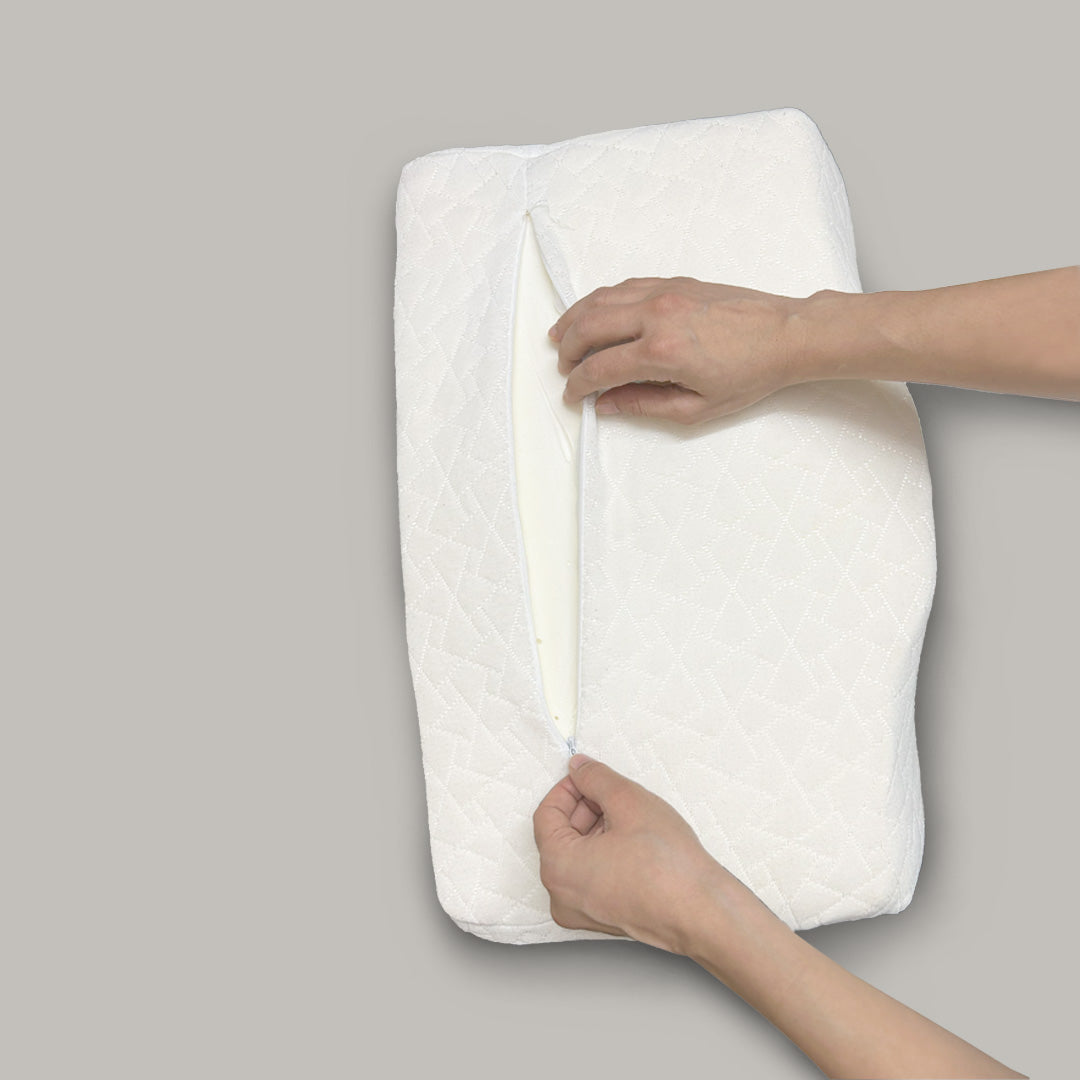
How to Care for and Extend the Life of Your Memory Foam Pillow
Share
Memory foam pillows are popular for their ability to conform to the shape of your head and neck, providing amazing support and comfort. However, to maintain their quality, support, and hygiene, proper care is element. In this comprehensive guide, we’ll explore the steps and best practices for caring for your memory foam pillow, ensuring it lasts for years.
Shape Conformance: Fits to the shapes of your head and neck.
Pressure Relief: Relieves the strain on pressure dots.
Durability: Retains its shape much longer than average pillows.
In even of these, memory foam pillows need specific care because their easy work can easily be ruined by water or aggressive cleaning products.
How to Spot Clean:
Dilute the mild detergent in lukewarm water.
Dip a clean cloth or sponge into the soapy solution, then gently dab the contaminated place.
With a wet cloth, remove the soap dirt.
Let the pillow to dry completely in air before use.
Step-by-Step Guide
Preparation: Remove the pillow cover or protector.
Hand Wash Only: Put the padded in warm water with just a little of normal soap. Hot water may harm the foam, so stay away from using it.
Gently Squeeze: Compress the foam lightly to allow the water and detergent to penetrate, but do not wring or twist.
Rinse Thoroughly: Use clean water to rinse out all soap.
Dry Completely:
Press the pillow gently with a dry towel to remove it water.
It should air dry in an place with adequate ventilation, away from heat sources and direct sunshine.
Do Not Fold or Bend: Never fold or bend your pillow for more than a few days.
Flip Often: Flip or turn your pillow each week so wear is equally spaced.
Avoid Heavy Weight: Do not put heavy things on your pillow this may compress the foam.

Waterproof Covers: Protects against spills and stains.
Breathable Covers: Use cotton or bamboo covers to allow for airflow and dissipate heat.
Washable Covers: The cover should be machine washable for easy cleaning.
Air Pillows Frequently: Spray the pillow in an open place after a week.
Baking Soda Treatment
To absorb all undesirable odours, sprinkle baking soda across the pillow and let it sit for at least half an hour.
Vacuum the pillow especially thoroughly with a hand vacuum that has a brush attachment.
Use Essential Oils: Add a few drops of lavender or eucalyptus oil to the pillow cover for a fresh scent.
The pillow may be stored in a cool, dry location away from moisture and direct sunlight.
Use a Pillow Bag: Place it in a breathable bag to prevent dirt buildup.
Avoid Compression: Store the pillow flat to maintain its shape.
Avoid Direct Heat: Keep the pillow away from radiators, heaters, or direct sunlight, heat can degrade the foam.
Handle Gently: When moving or changing the pillow, handle it carefully to prevent tears.
Replace When Necessary: Memory foam pillows need to be replaced every 2-3 years even with proper care the foam will eventually lose its elasticity and support.
Overwashing: Frequent washing can weaken the foam. Only do spot cleaning and deep cleaning on time.
Using Harsh Chemicals: Bleach, strong detergents, and fabric softeners can degrade the foam.
Skipping Drying: Never use a pillow that isn't completely dry, this can lead to mold and mildew growth.
Humidity: High humidity can encourage mold growth. Use a dehumidifier if necessary.
Temperature Sensitivity: Memory foam reacts to temperature, becoming firmer in cold conditions and softer in warm ones. Store it in a stable temperature environment.
Cooling Gel Layers: Keep the sleep warm for warm sleepers
Customizable Inserts: You get to change to height and firmness
Pillow Wedges: For side or back sleepers
Loss of Support: The pillow no longer conforms to your head and neck.
Visible Damage: Tears, cracks, or permanent indentations in the foam.
Persistent Odors: Unremovable smells despite thorough cleaning.
Allergy Symptoms: Increased allergies due to trapped allergens.
Understanding Memory Foam Pillows
A chemically doped polyurethane product with improved density and viscosity is called memory foam. This type of material features some special characteristics:Shape Conformance: Fits to the shapes of your head and neck.
Pressure Relief: Relieves the strain on pressure dots.
Durability: Retains its shape much longer than average pillows.
In even of these, memory foam pillows need specific care because their easy work can easily be ruined by water or aggressive cleaning products.
1. How to Clean Your Memory Foam Pillow

a. Regular Spot Cleaning
When to Spot Clean: As soon spills or stains appear, spot cleaning needs to be done.How to Spot Clean:
Dilute the mild detergent in lukewarm water.
Dip a clean cloth or sponge into the soapy solution, then gently dab the contaminated place.
With a wet cloth, remove the soap dirt.
Let the pillow to dry completely in air before use.
b. Deep Cleaning
Deep cleaning should be done 2-3 times a year to ensure hygiene is at its best.Step-by-Step Guide
Preparation: Remove the pillow cover or protector.
Hand Wash Only: Put the padded in warm water with just a little of normal soap. Hot water may harm the foam, so stay away from using it.
Gently Squeeze: Compress the foam lightly to allow the water and detergent to penetrate, but do not wring or twist.
Rinse Thoroughly: Use clean water to rinse out all soap.
Dry Completely:
Press the pillow gently with a dry towel to remove it water.
It should air dry in an place with adequate ventilation, away from heat sources and direct sunshine.
c. Avoid Machine Washing
Memory foam is too fragile to be washed in a washing machine or put in the clothes dryer. The agitation and heat could break up the foundation of the foam.2. Flattening Your Memory Foam Pillow
Memory foam is supposed to retain its shape, but sometimes improper handling causes deformity.Do Not Fold or Bend: Never fold or bend your pillow for more than a few days.
Flip Often: Flip or turn your pillow each week so wear is equally spaced.
Avoid Heavy Weight: Do not put heavy things on your pillow this may compress the foam.
3. Pillow Covers: Protecting Your Pillow
By using protective covers, you may notable extend the life of your memory foam pillow:
Waterproof Covers: Protects against spills and stains.
Breathable Covers: Use cotton or bamboo covers to allow for airflow and dissipate heat.
Washable Covers: The cover should be machine washable for easy cleaning.
4. Odors and Allergens
If memory foam is not properly maintained, it may hold allergies, dirt, and smells.Air Pillows Frequently: Spray the pillow in an open place after a week.
Baking Soda Treatment
To absorb all undesirable odours, sprinkle baking soda across the pillow and let it sit for at least half an hour.
Vacuum the pillow especially thoroughly with a hand vacuum that has a brush attachment.
Use Essential Oils: Add a few drops of lavender or eucalyptus oil to the pillow cover for a fresh scent.
5. Storage Tips for Memory Foam Pillows
If you’re not using your memory foam pillow for an extended period, proper storage is element:The pillow may be stored in a cool, dry location away from moisture and direct sunlight.
Use a Pillow Bag: Place it in a breathable bag to prevent dirt buildup.
Avoid Compression: Store the pillow flat to maintain its shape.
6. Longevity Tips: Extending the Life of Your Pillow
In order to extend the life of your memory foam pillow:Avoid Direct Heat: Keep the pillow away from radiators, heaters, or direct sunlight, heat can degrade the foam.
Handle Gently: When moving or changing the pillow, handle it carefully to prevent tears.
Replace When Necessary: Memory foam pillows need to be replaced every 2-3 years even with proper care the foam will eventually lose its elasticity and support.
7. Common Mistakes to Avoid
Avoid these common pitfalls that can damage your memory foam pillow:Overwashing: Frequent washing can weaken the foam. Only do spot cleaning and deep cleaning on time.
Using Harsh Chemicals: Bleach, strong detergents, and fabric softeners can degrade the foam.
Skipping Drying: Never use a pillow that isn't completely dry, this can lead to mold and mildew growth.
8. Environmental Factors to Consider
Memory foam is sensitive to environmental conditions:Humidity: High humidity can encourage mold growth. Use a dehumidifier if necessary.
Temperature Sensitivity: Memory foam reacts to temperature, becoming firmer in cold conditions and softer in warm ones. Store it in a stable temperature environment.
9. Enhancing Comfort with Accessories

Cooling Gel Layers: Keep the sleep warm for warm sleepers
Customizable Inserts: You get to change to height and firmness
Pillow Wedges: For side or back sleepers
10. Telltale Signs It's Time to Get a New Pillow
Memory foam pillows have an expiry date; look out for these signs so you know you should get a new one.Loss of Support: The pillow no longer conforms to your head and neck.
Visible Damage: Tears, cracks, or permanent indentations in the foam.
Persistent Odors: Unremovable smells despite thorough cleaning.
Allergy Symptoms: Increased allergies due to trapped allergens.
